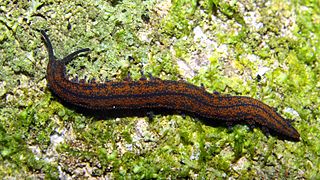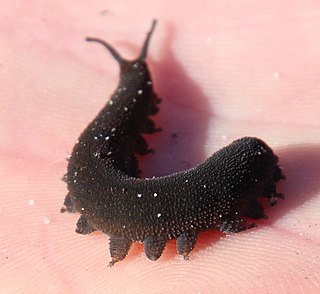
Onychophora, commonly known as velvet worms or more ambiguously as peripatus, is a phylum of elongate, soft-bodied, many-legged panarthropods. In appearance they have variously been compared to worms with legs, caterpillars, and slugs. They prey upon other invertebrates, which they catch by ejecting an adhesive slime. Approximately 200 species of velvet worms have been described, although the true number of species is likely greater. The two extant families of velvet worms are Peripatidae and Peripatopsidae. They show a peculiar distribution, with the peripatids being predominantly equatorial and tropical, while the peripatopsids are all found south of the equator. It is the only phylum within Animalia that is wholly endemic to terrestrial environments, at least among extant members. Velvet worms are generally considered close relatives of the Arthropoda and Tardigrada, with which they form the proposed taxon Panarthropoda. This makes them of palaeontological interest, as they can help reconstruct the ancestral arthropod. In modern zoology they are particularly renowned for their curious mating behaviours and the bearing of live young in some species.

Peripatoides indigo is a velvet worm of the family Peripatopsidae. The Māori name for the velvet worm is ngaokeoke, from the Māori word 'ngaoki', to crawl.

Peripatoides is a genus of velvet worms in the family Peripatopsidae, whose species are found in New Zealand. Like all velvet worms, these animals are nocturnal hunters that spit glue to trap their prey. Species of Peripatoides have 14, 15 or 16 pairs of legs. Female Peripatoides produce eggs that are fertilized internally and babies develop inside their mother until large enough to be born, in batches of 4-6, as colourless miniatures of the parents. These live-bearing Peripatoides have dermal-haemocoelic sperm transfer - which means sperm dissolve holes in the skin of the female to enter the body (haemolymph) anywhere on the body wall of the female.
Peripatoides suteri is a species of velvet worm in the Peripatopsidae family. This species is ovoviviparous has 16 pairs of legs. It is endemic to New Zealand.

Peripatidae is a family of velvet worms. The oldest putative representatives of the family herald from Burmese amber dated to the mid-Cretaceous, around 100 Ma, with representatives from Dominican and Baltic amber attesting to a broader distribution in the Palaeogene / Neogene; molecular variability suggests that the family's crown group may have arisen in the early Mesozoic.

Peripatopsidae is one of the two living velvet worm families.

Occiperipatoides is a monospecific genus of velvet worm containing the single species Occiperipatoides gilesii. This genus is ovoviviparous and found in Western Australia. The genus is part of the ancient phylum Onychophora that contains soft-bodied, many-legged relatives of arthropods known commonly as velvet worms.

Ooperipatellus is a genus of Australian and New Zealand velvet worms in the Peripatopsidae family. Species in this genus are oviparous. Velvet worms in this genus are among the smallest known, with adults often only 10 to 20 millimeters long. Morphological and molecular data indicate that this genus is a monophyletic group.
Opisthopatus cinctipes is a species of velvet worm in the Peripatopsidae family. This species has 16 pairs of legs, all with claws and all used for walking. The type locality is in South Africa.
Peripatoides kawekaensis is a species of velvet worm in the Peripatopsidae family. This species is ovoviviparous and has 15 pairs of legs. The type locality is in New Zealand's North Island.
Cephalofovea clandestina is a species of ovoviviparous velvet worm in the family Peripatopsidae. This species has 15 pairs of oncopods (legs) and lives in rotting logs and leaf litter. The type locality is Kanangra-Boyd National Park, New South Wales, Australia. Like all members of the genus Cephalofovea, both sexes of C. clandestina have a furrow on the head, between the antennae, which the male everts to carry his spermatophore to the female.
Cephalofovea pavimenta is a species of velvet worm in the Peripatopsidae family. It is only known from the type locality; Mount Canobolas in New South Wales, Australia.
Cephalofovea tomahmontis is a species of velvet worm in the Peripatopsidae family. This species is ovoviviparous, has 15 pairs of oncopods (legs), and lives in rotting logs and leaf litter. The type locality is Mount Tomah, New South Wales, Australia, after which this species is named. Like all members of the genus Cephalofovea, both sexes of C. tomahmontis have a furrow on the head, between the antennae, which the male everts to carry his spermatophore to the female.
Ooperipatellus insignis is a species of velvet worm in the family Peripatopsidae. This species has 14 pairs of legs and is found in Victoria, Australia.

Ooperipatellus viridimaculatus is a species of velvet worm in the family Peripatopsidae. This species is oviparous, has 14 pairs of legs, and is brown or orange in color with two rows of green spots along its back. It is found in the South Island of New Zealand.
Paraperipatus ceramensis is a species of velvet worm in the family Peripatopsidae. Females of this species have 21 or 22 pairs of oncopods (legs). The type locality is in Seram, Indonesia.
Paraperipatus papuensis is a species of velvet worm in the Peripatopsidae family. Males in this species have 21 to 27 pairs of legs; females have 21 to 29 leg pairs. The maximum number of leg pairs recorded in this species (29) is also the maximum number of leg pairs found in the family Peripatopsidae. The type locality is in Western New Guinea, Indonesia.
Peripatopsis balfouri is a species of velvet worm in the Peripatopsidae family. This species has 18 pairs of clawed legs. The type locality is in South Africa.

Peripatopsis capensis is a species of velvet worm in the Peripatopsidae family. This species has 18 pairs of legs: 17 pregenital leg pairs with claws plus one last pair that is strongly reduced and without claws or spinous pads. The native range of this species is limited to the Cape Peninsula of South Africa.
Peripatopsis sedgwicki is a species of velvet worm in the Peripatopsidae family. This species can have either 20 or 21 pairs of legs, but descriptions usually report 20 pairs of clawed legs. The type locality is in South Africa.









